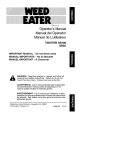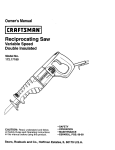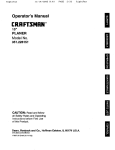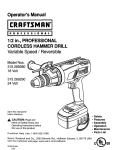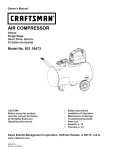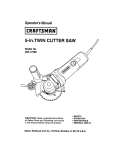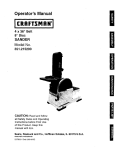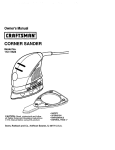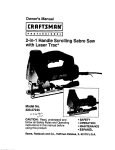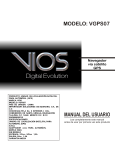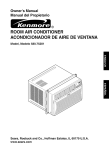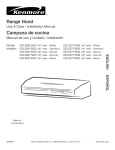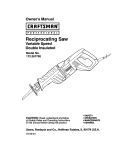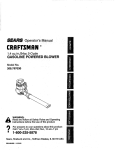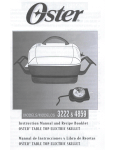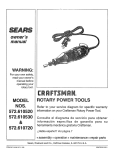Download Craftsman 172.26729 Owner`s manual
Transcript
Owner's Manual ICRAFTSMAN I 31/4-1N. PLANER Model No. 172.26729 CAUTION: Read, understand and follow all Safety Rules and Operating Instructions in this manual before using this product, Sears, Roebuck and Co., Hoffman • • • • SAFETY OPERATION MAINTENANCE ESPANOL, PAGINA 21 Estates, IL 60179 U.S.A. all ip_ructions listed below may result in electric shock, fire and/or J to Z_follow WARNING: BE SURE to read and understand all instructions. Failure serious personal injury. I J WORK AREA SAFETY 1. ALWAYS keep your work area clean and well IlL Cluttered and dark areas Invite accidents. 2. DO NOT operate power tools In explosive atmospheres, such as In the pm._e.nce of flammable liquids, gases, or dust. Power tools create sparks wnucnmay ignitethe oustor Rimes. 3. ALWAYS keep bystanders, children and visitors away while operating a power tool. Distractions can cause you to lose control. ELECTRICAL SAFETY 1. Double Insulated tools ere equipped with e polarized plug (one blade Is wider than the other). This plug will fit in a polarized outlet only one way. If the plug does not fit fully into the outlet, reverse the plug. If It still does not tit, contact a qualified electrician to Install a potarlzed outleL DO NOT change or alter the plug In any way. 2. Double insulation [] eliminates the need for the three wire grounded power cord and grounded power supply system. Applicable only to Class II (double insulated) tools. 3. Before plugging in the tool BE SURE that the outlet voltage supplied is within the voltage marked on the tool's data plate. DO NOT use =AC only" rated tools with a DC power supply. 4. ALWAYS avoid body contact with grounded surfaces, such as pipes, radiators, ranges and refrigerators. There is an increased dsk of electric shock if your body is grounded. 5. If operating the power tool In damp locations Is unavoidable, ALWAYS use a Ground Fault Circuit Interrupter to supply power to your tool. ALWAYS wear electrician's rubber gloves and footwear In damp conditions. 6. DO NOT expose power tools to rein or wet condlUons. Water entering a power tool will increase the dsk of electric shock. 7. DO NOT abuse the cord. NEVER use the cord to carry the tools or pull the p.lug from the outlet. Keep cord away from heat, o11,sharp edges or movnng parts. Replace damaged cords Immediately. Damaged cords increase the risk of electric shock. 8. When operating a power tool outside, ALWAYS use an outdoor extension cord marked "W-A" or _ These cords are rated for outdoor use and reduce the risk of electric shock. NOTE: The extension cord must have adequate wire size AWG (American Wire Gauge) for safe, efficient use. Smaller gauge wires have greater capacity (16 gauge wire has more capacity than 18 gauge wire). 3 PERSONAL SAFETY 1. ALWAYS stay alert, watch what you are doing and use common sense when operatlng s power tool. DO NOT use tool while tired or under the influence of drugs, alcohol or medication. A moment of inattentionwhile operating power tools may result in serious personal injury. 2. ALWAYS dress properly. DO NOT wear loose clothing or Jewelry. Pull back long hair. Keep _/our hair, clothing and gloves away from moving parts. Loose clothing,jewelry or long hair can be caught in moving parts. 3, ALWAYS avoid accidental starting. BE SURE switch Is in the "Off" position before plugging in. DO NOT carry tools with yourfinger on the switch.Carrying tools with your finger on the switch or pluggingin toolsthat have the switch in the "On" positioninvitesaccidents. 4. ALWAYS remove adjusting keys or wrenches before turning the tool on. .Awrench or a key that is left attached to a rotating part of the tool may result in personal injury. 5. DO NOT overreach. ALWAYS keep proper footing and balance at all times. Proper looting and balance enables better controlof the tool in unexpected situations. 6. ALWAYS use safety equipment. Always wear eye protection. Dust mask, non-skid safety shoes, hard hat, or hearing protection mustbe used for appropriate conditions. TOOL USE AND CARE SAFETY 1. ALWAYS use clamps or other practical ways to secure and support the work piece to a stable platform. Holding the work by hand or against your body is unstable and may teed to loss of control. 2. DO NOT force the tool. Use the correct tool for your application. The correct tool willdo the job better and safer at the rate for which it is designed. 3. DO NOT use the tool if the switch does not turn it "On" or "Off", Any tool that cannot be controlledwith the switch is dangerous and must be repaired. 4. ALWAYS disconnect the plug from the power source before making any adjustments, changing accessories or storing the tool. Such preventive safety measures reduce the risk of starting the tool accidentally. 5. ALWAYS store Idle tools out of the reach of children and other untrained persons. Toolsare dangerous in the hands of untrainedusers. 6. ALWAYS maintain tools with care. Keep cutting tools sharp and clean. Properly maintained toolswith sharp cutting edges are less likelyto bind and are easier to control. 7. ALWAYS check for misallgnment or binding of moving ports, breakage of parts, and any other condition that may affect the tool's operation. If damaged, have the tool serviced before using. Many accidents are caused by poorly maintained tools. 4 TOOLUSEANDCARESAFETY cont. /_ WARNING: USEOF ACCESSORIESTHATARE NOT RECOMMENDED I FOR USEWITHTHISTOOL MAYCREATEA HAZARDOUSCONDITION. I 8. ALWAYS use only accessorles that are recommended for this tool. Accessories that may be suitable for one tool can become hazardous when used on another tool. SERVICE SAFETY I. If any part of this planer is missing or should break, bend, or fail in any way; or should any electrlcal component fall to perform properly: ALWAYS shut offthe power switchand remove the planer plug from the power source and have the missing,damaged or tailed parts replaced BEFORE resuming operation. 2. When servicing a tool, ALWAYS use only Identical replacement parts. Follow Instructions In the maintenance section of this manual. Use of unauthorizedparts may create a risk of electricshock or injury. 3. Tool service MUST BE performed only by a Sears Parts and Repair Center. Service or maintenance performed by unqualifiedpersonnel could result in a risk of injury. ADDITIONAL RULES FOR SAFE OPERATION ,/_ WARNING: BE SURE to read and understandall instructions.Failure I to follow all instructionslisted below may resultin electricshock,fire and/or serious personal injury. 1. Know your power tool. Read operator's manual carefully. Learn the applications and limitations as well as the specific potential hazards related to th s tool. Followingthis rule will reduce the nsk of electric shock, fire or serious injury. 2. ALWAYS wear safety glasses or eye shields when using this planer. Everyday eyeglasses have only impact-resistant lenses; they are NOT safety glasses. Followingthis rule will reduce the risk of serious personal injury. 3. ALWAYS protect your lungs.Wear a face mask or dust mask if the operation is dusty. Followingthis rule will reducethe risk of serious personal injury. 4. ALWAYS protect your hearing.Wear hearing protection during extended periods of operation. Followingthis rule will reduce the risk of serious personal injury. 5. ALWAYS inspect the tool cords periodically and if damaged have them repaired at your nearest Sears Service Center or other Authorized Service Facility. ALWAYS be aware of the cord location. Followingthis rule will reduce the risk of electric shock or fire. I ADDmONAL RULES FOR SAFE OPERATION cont. 6. ALWAYS check for damaged parts. Before further use of the toot, a guard or other part that is damaged should be carefully checked to determine If it will operate properly and perform its intended function. Check for misallgnment or binding of moving pads, breakage of parts, and any other condition that may affect the tool's operation. A guard or other part that is damaged should be properly repaired or replaced at a Sears Service Center. Followingthis rule will reduce the risk ofa ectr c shock, fire or serious injury. 7. DO NOT abuse the cord. NEVER use the cord to carry the tools or pull the plug from the outlet. Keep cord away from heat, oil, sharp edges or moving parts. Replace damaged cords immediately. Damaged cords increase the risk of eleCtriCshock. Followingthis rule will reduce the risk of electric shock or fire. 8. ALWAYS make sure that your extension cord Is in good condition. When using an extension cord be sure to use one that is heavy enough to carry the current that your tool will draw. A wire gauge (AWG) of at least 14 is recommended for an extension cord 25 feet or less in length. When workingoutdoors ALWAYS use an extension cord that is suitable for outdoor use. The cord'sjacket will be marked WA. Smatter gauge wires, have greater capacity (16 gauge wire has more capacity than 18 gauge wire). An undersized cord willcause a drop in line voltage, resulting in loss of power and overheating. 9. ALWAYS inspect and remove all nails from lumber before planing, Followingthis rule will reduce the risk of serious personal injury. 10. DO NOT use the tool while tired or under the Influence of drugs, alcohol or any medication. Followingthis rule willreduce the risk of electric shock, fire or serious persona_ iniury. 11. SAVE THESE INSTRUCTIONS. Refer to them frequently and use them to instruct others who may use this tool. If someone borrows this tool, make sure they have these instructions also. 6 ADDITIONAL RULES FOR SAFE OPERATION cont. /_ WARNING: The operation of any planer can result in foreign objects being thrown intoyour eyes, which can result in severe eye damage. Before beginning powertool operation,ALWAYS wear safety goggles or safety glasses with side shield and a full face shield when needed. We recommend A Wide Vision Safety Mask for use over eyeglasses or standard safety glasses with side shield, available at Sears Retail Stores. L_WARNING: Some dust particles created by power sanding, sawing, grinding, drilling and other construction jobs contain chemicals known to cause cancer, birth defects or other reproductive harm. Some examples of these chemicals are: • Lead from lead-based paints. • Crystalline silica from bricks and cement and other masonry products. • Arsenic and chromium from chemically-treated lumber. Your risk from these exposures varies, depending upon how often you do this type of work.To reduce your exposure to these chemicals: • Work in a well-ventilated area. • Work with approved safety equipment such as those dust masks that are specially designed to filter out microscopic particles. The label on your tool may include the following symbols. V........................................................................... Volts A .......................................................................... Hz........................................................................ W .......................................................................... rain ...................................................................... ........................................................................ .... ................................................................... no ........................................................................ [] ........................................................................ .../rain .................................................................. Amperes Hertz Watts Minutes Alternating current Direct current No-load speed Class II construction Revolutions or reciprocation per minute Z_ ........................................................................ Indicates danger, warning caution. It means attention!!! Your safety is involved, IMPORTANT! READ ALL INSTRUCTIONS 7 KNOWYOUR PLANER (SeeFig.1) Beforeattempting to use any tool, be ,sureto familiarize yourself with all the operating features and safety instructions. Your planer has many built-inconveniencefeatures for fast, efficientcutting. It is compact and lightweightfor easy, comfortableuse. The depth adjustment knob is conveniently located at the front of the planer and allows easy depth adjustments from 0 to 1/8-in. to suit your needs. Your planer uses reversible, double-edged hardened steel carbide-tippedblades that allow use on both sides for longer blade life. It includesedge guide for accurate cuts on long or uneven work pieces.The rabbet guide allowsyou to make rabbet cuts up 15/16 in. deep. Electrical Connection Yourplaner has a precision-builtelectricmotor and it shouldonly be connected to a 120-volt, 60-Hz. power supply (normal household current). DO NOT operate on direct current (DC).This large voltage drop will cause a loss of power that witl overheat the motor.If your saw does not operate when plugged into an outlet check the power supply. Trigger Switch and On/Off Button To turn on the planer press and hold the On/Off button and squeeze the trigger switch.When you are finished planing, release switchto shut tool off. Adjustable Left or Right Dust / Chip Extraction The dust / chip chute can be adjusted for left or right extractionby turningthe chute clockwise or counterclockwise. Base Plate Stand Whenever you place the planer onto a work surface, the rear of the base plate should be elevated on this stand. This will help protectthe planer blades from damage and help preventthe blades from accidentallydamaging the work surface.As you begin to plane, this stand will he pushed away by the work surface.ALWAYS be sure that the stand moveseasily on the base plate. input 7 Amps Cutting Width 3 1/4 in. Cutting Depth 0 to l/B-in. Max. Rabbet Cut 15/16-in. Rating 120 volts, 60 Hz AC No-Load Speed 12,000 RPM | I when you are assemblingparts,makingadjustments,changingbeltsor blades, cleaningplaner,or not in use,Disconnecting planerwillpreventaccidental I/Jk WARNING: when Your planer shouldNEVERbeconnected topowersupply I startingthatcouldcauseseriousinjury. PREPARING FOR OPERATION Your planer has a rear handle and front assist handle for ease of operation.They provide the two-hand operation which is necessary to maintain proper controlof the planer.ALWAYS keep both hands clear of the blades and the cutting area. ALWAYS usa both hands when using the planer. Hold the front handle with your left hand and the rear handle w_h your right hand (as shown in Fig. 2). This position makes your planer easier to handle and keeps you clear of the chip exhaust. The work moving during a cut could result in the loss of controlof the planer, possiblycausing serious injury. A ! ZL_ CAUTION: DO NOT plane too fast because this causes buildup in I the chip exhaust.Chip build-up restrictsair flow and can cause the motor to over heat. I Keep the cord away from the cutting area. ALWAYS place the cord so it does not hang on the work when you are making a cut. /_, DANGER: If the cordhangs up on the work duringthe cut, release the I tdgger switchimmediately.Unplugthe planer and checkthe cordfor damage. If there is no damage, repositionthe cordto preventit from hangingup again. If the cord has been damaged, have it replaced before usingyourplaner. I Z_ WARNING: Using your planer with a damaged cord couldcause electricalshock resulting in seriousinjury. I I THE CORRECTWAYTO USEYOUR PLANER (See Fig. 2) ALWAYS hold your planer as shown in Figure 2. 1. ALWAYS keep controlof your planer. It makes cutting easier and safer, as shown in Figure 2. 2. To help keep control ALWAYS supportyour work so the cut willbe on your right. 3. ALWAYS clamp your work so it does not move during the cut (see Figure 2). The work moving during a cut could result in the loss of controlof the planer, possiblycausing serious injury. The work movingduring a cut could result in the loss of controlof the planer, possiblycausing serious injury. 10 THECORRECT WAYTOUSEYOUR PLANER (SeeFig,2)cont. 4,ALWAYS operatetheplanerwiththe chipchuteexhaust turnedsoit points away from your face and eyes. All visitors should wear safety glasses and be kept a safe distance from the work area. 5, ALWAYS hold your planer so the blades DO NOT come in contact with the work piece BEFORE you squeeze the trigger switchand start the planer. Z_ WARNING: Keep a firm grip on the tool with both hands at all times. Failure to do so could result in loss of control leading to possible serious injury. TO ADJUST PLANING DEPTH (See Fig. 3) The planing depth on your planer can be adjusted from 0 to 1/8 inch by rotating the depth adjustment knob located on the front of your planer, 1. Unplug your planer. I starting, causing serious injury. Z_ WARNING: Failure to unplug your planer could result in accidental 2. To increase cutting depth rotate knob n a c ockwise direction. 3. To decrease cutting depth, rotate knob in a counterclockwisedirection, 4. We recommend that you make test cuts in scrap wood after each adjustment to make sure the planer is removingthe desired amount of wood. NOTE: To protect the blades during storage, transporting and when not in use, ALWAYS set the blade depth adjustment to 0. 11 I GENERAL CUTTING 1. Adjust planer to desired depth. 2. ALWAYS grip the planer with your left-hand holdingthe front handle and your right hand holdingthe top handle. 3, Place front shoe fiat on the work piece, ALWAYS make sure that the blades are not touchingthe work piece. 4. Apply pressure to the front handle untilthe front shoe is fiat on the work piece. 5. Push the On/Off button and Squeeze the trigger switchto start the planer and allowthe motor to reach maximum speed. 6. Hold the planer firmly and push it steadily in a forward directiononto the work piece. NOTE: If you desire a smooth cut, pushthe planer slowlyin a forward direction. 7. As you reach the end of your desired cut, ALWAYS apply downward pressure toward the rear handle. This will help keep the rear sectionof the base in contact with the work piece and help preventthe front ofthe planer from dippingand gouging your cut. 8. ALWAYS be careful to avoid hittingnails during the planingoperation because this could nick, crack or otherwise damage the blades. NOTE:The blades in your planer are reversible, so they can be rotated until both sides are dull. NOTE: We suggest that you keep an extra set of blades on hand, so you can replace the blades in your planer when they show signsof becomingdull. Always reverse or replace blades in pairs. EDGE PLANING / CHAMFERING (See Figure 4) Yourplaner is designed with a groove in the front shoe.This groove is for chamferingthe edges of boards (see Fig. 4). NOTE: ALWAYS make a practice cut on scrap wood to determine how much wood needs to be removedfrom the board BEFORE making your actual cut. 1. Firmly hold the rear handle of the planer with your left hand and the top handle with your right hand. 2. Place the groove on the planer on to the surface to be cut. 3. Turn on planer and let it reach full speed. 4. Slowly move planer onto work. 5. ALWAYS maintain downward pressure on the planer to keep it flat at the beginning and the end of the work piece. NOTE: Making several passes of more shallow cuts will provide a smoother cut and makes it easier to control planer. 12 Fig. 4 ,/ // ACCESSORIES INCLUDED WITH YOUR PLANER To make yourplaner even more versatilewe have included 2 special accessories. They are an Edge Guide and a Rabbeting Plate. ATTACHINGTHE EDGE GUIDE (See Figure 5) 1. Unplug your planer. your planer could resultin accidental I starting,causing /_ WARNING: serious Failureto unplug I injury. 2. Insert the screw provided throughthe hole in the edge guide. 3. Tighten screw securely into screw hole on either side of the main shoe (see Fig. 5). USING THE EDGE GUIDE The Edge Guide easily attaches to either side of the planer. It is ideal for planing long and uneven boards. 1. When making cuts with the Edge Guide ALWAYS hold it firmly against the edge of the board you are planing. ATTACHINGTHE RABBET GUIDE (See Fig. 6) 1. Unplug your planer. /_ WARNING: Failureto unplugyour planer could resultin accidental starting,causing serious injury. 2. Insert the screw provided through the flat washer, then through the slot in the rabbeting plate, 3. Insert screw intoscrew hole on the rightside of the main shoe and tighten securely (see Fig. 6). USING THE RABBET GUIDE The Rabbet Guide attaches to the right side of the planer. It is ideal for making rabbeting cuts up to 15/16 inches thick. The maximum width of cut is 15/16-inch per cut. 1. When making a rabbet cut, ALWAYS place the notch on the inside of the main shoe firmly against the side of the board (see Fig. 6). 2. ALWAYS press the Rabbet Guide firmly against the top surface of the board. 13 Nolch I I TO ADJUSTTHE DEPTH OF RABBEt" CUT 1. Unplug your planer. I /_ starting, WARNING: causingserious Failureto injury. unplugyour planer could result in accidental i 2. Place planer on a flat board or work piece. 3. Loosen the screw and positionthe bottom surface of the Rabbet Guide above the board the same distance as the desired depth of cut. 4. Tighten screw securely. REPLACINGTHE BLADES (See Figures 7 to 9) The blades in this planer are reversible,so when the blades become dull, they can be reversed. ALWAYS REPLACE OR REVERSETHE BLADES IN PAIRS. DO NOT ATTEMPTTO SHARPEN THE BLADES. NEVER OPERATE YOUR PLANER WITH ONLY ONE BLADE INSTALLED. 1. Unplug your planer. I starting,causing _, WARNING: serious Failureto unplug your planer couldresult in accidental injury. 2. Place the planer upside down on the work bench. (See Fig. 7). 3. Use the wrench (included) to loosen the 3 bolts that hold the blade to the blade clamp.To loosen bolts, turn them approximately 1/2 turn in a clockwise direction. (See Fig. 7). 4. Hold the blade clamp in position and use a piece of wood to slide the blade out of blade clamp. (See Fig. 8). 5. Push down on blade guard when removing the blade from the blade clamp. (See Fig. 8), Fig. 8 of Wood Work Bench 14 REPLACINGTHE BLADES (See Figures 7 to 9) conL I carefully Z_ CAUTION: Blades are result very sharp. ALWAYS handle bladesvery Failureto do so could in possibleseriousinjury. NOTE: DO NOT remove the blade clamp.This could alter the factory setting for cuttingheight and blade height. NOTE: DO NOT adjust the height adjusting screws. 6. Place new blade or reverse existing blade into blade clamp. (See Fig. 9), 7. Check to be sure blade is properly positioned in blade clamp and the blade edge is level with the base. (See Fig. 9). 8, Securely re-tighten the 3 bolts. 9, Repeat the steps 3 through 8 above to change or reverse the other blade. 10. Remove piece of wood from planer. Z_ Warning: ALWAYS remove the piece of woodbefore starting your planer.Failureto do so could result in the piece of wood being thrown from your planer, causingpossibleserious injury. USING THE LEFT OR RIGHT DUST / CHIP EXTRACTION (See Figure 10) The dust / chip chute can be adjusted for left or right extraction. Turn chute clockwise for extraction on the left side, or turn it counterclockwise for extraction on the right side.The arrow on the top of the chute indicates the direction the chips will be extracted. 15 J I SERVICE may result In misplacingof Internal wires and components,which I personnel k WARNING: Preventativemaintenanceperformedby unauthorized could causea serioushazard. • All service that requires opening the planer MUST only be performed by a Seam Service Center. All motor parts represent an important part of the double insulation system and MUST only be serviced by a Sears Service Center. Service performed by unqualified personnel could result in a risk of injury. • When servicing this tool, ALWAYS use only identical replacement parts. Follow instructions in the Maintenance Section of this manual Use of unauthorized parts or failure to follow Maintenance instructions may create a risk of electrical shock or injury, • Avoid solvents when cleaning plastic parts. Most plastics are susceptible to damage from various types of commercial solvents and may be damaged by their use. Use clean cloths to remove dirt, carbon dust, etc. GENERAL I Z_ WARNING: Toavoidaccidents, ALWAYS disconnectthetcol from the powersourceBEFOREcleaning or performing anymaintenance. All parts represent an important part of the double insulation system and shcu d be serviced only at a Sears Service Center. pelroleum-basedproducts,penetratingoils, etc., come in contactwith plasticparts. I They _ WARNING: DO NOT anytime let brake contain chemicalsthat canatdamage,weaken orfluids,gasoline, destroy plastic. It is a knownfact that electric tools are subject to accelerated wear and possible premature failure when they are used to work on fiber glass boats and sports cars, wallboard, speckling compounds or plaster. The chips and grindings from these materials are highly abrasive to electrical tool parts, such as bearings, brushes, commutators, etc. Consequently, it is not recommended that this tool be used for extended work on any fiber glass material, wallboard, spackling compound, or plaster. During any use on these materials, it is extremely important that the tool is cleaned frequently by blowing with an air jet. 16 LUBRICATION All of the bearings in this tool are lubricatedwith a sufficientamount of high-grade lubricantfor the life of the tool under normal operating conditions, Therefore, no further lubrication is required. I shieldswhenusing Z_ WARNING: thistoolorblowing ALWAYSwearsafetygoggles dust.Ifoperation orisdusty, safetyglasses alsoweara withside dustmask.I DOUBLE INSULATION Double insulationis a safrty feature in safety in electric power tools, that eliminates the need for the standard 3-wire grounded powercord. All exposed metal parts are isolated from the internal motorcomponentswith protecting insulation.Double insulatedtools do not need to be grounded. EXTENSION CORDS Sears offers a large selection of extensioncords that help extend your working range. The use of any extension cord will cause some loss of power. To keep the loss at a minimum and to prevent overheating, use an extension cord that is heavy enough to carry the current that the tool willdraw, A wire gauge (AWG) of at least 14 is recommended for an extension cord 25 feet or less in length. When working outdoors ALWAYS use an extension cord that is suitable for outdoor use. The cord's jacket will be marked WA. I Z_ CAUTION: Keep extensioncords awayfrom thecuttingarea,and position the cordso itwill not get caughton lumber,tools,etc.during the cuttingoperation. I cords it immediately. NEVER use a tool with a damaged cord because touching the _ WARNING: Checkelectrical extensionshock, cords resulting before each use. Replace damaged area could cause in serious injury. damaged BLADES The blades for your planer are currentlyavailable at your local Sears Store. I recommended Z_ WARNING: The use of attachments or accessories that are not may be dangerous. 17 POWER PLANER - MODEL NUMBER 172.26729 The Model Numberwillbe foundonthe Nameplate.Alwaysmentionthe Model Number in all correspondenceregardingyourtool ,,,k Part No. SB19.0.02-00 SW55.58.0-00 SB19.0.15-00 SB19.0.05-00 ST05,07.21-00 SW56.12.0-00 SB19.0.21-00 SB19.0.07-00 SB19.0.22,-00 SB19.2.01-00 SB19.0.30-00 SB19.0.29-00 SB19.0.13-.00 SB19.0.01-00 SB19.0.12-00 STB50.15,00-00 ST01.02.04-00 SW50.11.3,-00 STB51.15.00-00 ST03.17.00-00 ST02,18.10-00 SB 19.0,06-.00 SB19.3.01-00 SB19.0.26-00 SB19.0.19-00 SW59.44.0.,00 SW55,57.0-00 SW60.75.0-00 SW55.11.0-00 SW50.12.0-00 SB19.0.20-(_ SW59.47.0-00 SB19.0.04-00 SB19.0J 6-00 SB19.1.06-00 D_mcrlptlon Handle Self-tanolna screw Rated lable Rlgnt cover Rubber dng Screw Rlna Quantity 1 22 1 1 4 1 Safetycover Spdng Bearing holder Ring Protection plate R)dng dng Houeing Chip elector Stator Rin,q Bearing Rotor Carbon brush Brush holder Wind shield Middle cover Belt Belt wheel Nut Self-tapplng screw Washer Self-tapping screw Beadng Belt wheel Nut Left cover Brand Screw 2 1 2 2 1 1 1 1 1 5 4 4 1 1 1 1 1 6 Part No. SW57,24.0-00 SB19.1.04-00 SB19.1.08-00 SB19.1.05-00 aB19.1.03-00 SW58.15.0-00 SB19.R02,.O0 SBlg.R04-O0 SB19.1.01-00 SW59.07,0-00 SW60.82.0-00 SB19.F.01-O0 SB19.0,14-00 SB19.0.18-00 SB19.0.17-00 SB19,0.25-0O SW59.61.0-00 SB19.F.03-O0 SBlg.O.03,-O0 aB19.0,23-00 SB19.0.24-00 SB19,0.11-00 SB19.0.28-00 SB19.0.09-00 SB19.0.08-00 SB19.0.10-00 8W21.32.21-00 ST08.01.03-00 SW55.56.0-00 ST05.01.01-00 SW02.32.03-00 ST25.33.02.2-00 ST25.23.02.0-00 ST25.23.02.2-00 SBlg.F.O6-OO SEE BACK PAGEFOR PARTSORDERINGINSI'RUC'nONS Ducdptlon Screw Upper blade hiD Blade Lower blade nlv Washer Bolt p_te Knob screw Blade drive shaft Nut Washer Parallel guide Stand Bock hue Front base Spdng Nut Devth aauae Frontcover Calibration divider Spdng C_dlbmtlonplate Rubber dng Knob stand Nut Knob Cable and Dlua Cable damp Self-ta_Dlng screw Cabte protector Switch Inter wire Inter wlre Inter wire Exmwtlonoutlet Qu_mty 4 2 2 2 1 1 1 2 1 1 1 1 1 1 1 1 2 1 1 1 1 1 1 1 1 1 1 1 2 1 1 2 1 1 1 POWER PLANER - MODELNUMBER 172.26729 1 I NOTES 20 Manual del Usuario CEPILLADORA DE 31/4 PULG. Modelo No. 172.26729 ATENCION: Antes de usar esta herramienta, lea, comprenda y siga todas las reglas de seguridad y las instrucciones de funcionamiento incluidas en este manual. Sears, Roebuck and Co., Hoffman • SEGURIDAD • FUNCIONAMIENTO • MANTENIMIENTO Estates, IL 60179 U.S.A. Garantfa ............................................................... Pdgina 22 Instrucciones P&ginas 23-27 Simbolos de Seguridad ................................. de Seguridad ........................................ P_gina 27 Descripci6n .......................................................... Funcionamiento ................................................... P&ginas 28-29 P_,ginas 30-35 Mantenimiento Pdgina 36-37 ...................................................... Accesorios ........................................................... Repuestos ............................................................ P_,gina 37 Pdgina 38-39 N_meros Contraportada de Servicio ............................................ GARANTIA COMPLETA DE UN AI_IO DE LA CEPILLADORA CRAFTSMAN PROFESSIONAL 31/4 PULGADAS DE Siesta cepilladora CRAFTSMAN falla debido a un defecto de material o de fabricaci6n dentro de un aSo de la fecha de compra, Sears la reparara gratuitamente EL SERVICIO BAJO LA GARANT|A PUEDE OBTENERSE SIMPLEMENTE DEVOLVIENDO LA HERRAMIENTA AL ALMACEN SEARS MAS CERCANO O A CUALQUIER OTRO DISTRIBUIDOR CRAFTSMAN EN LOS ESTADOS UNIDOS, Esta garantia le otorga derechos legales especfficos y usted puede ademas tener otros derechos que vadan de un estado a otro. Sears, Roebuck and Co. Dept. 817 WA, Hoffman Estates, IL 60179 iCONSERVE ESTAS INSTRUCCIONES! iLEATODAS LAS INSTRUCCIONES! 22 I las Instrucciones. El Incumplimlento de todas las Instrucclones slgulentes podr'a producirASEGURESE un choque el_trico, Incendlo y/o leslones ADVERTENCIA: de leery comprender todas personales graves. SEGURIDAD EN EL LUGAR DETRABAJO 1. SIEMPRE mantanga el Iugar de trabaJo Ilmplo y blen Ilumlnsdo. Las dreas de trabaJodesordenadae favomcen los accidentes. 2. NO utillce las herramientaa el_-4_'iese en atm6sfems explcolvas, tal coma en preaencls de Ifquldos Inflamablse, gases o polvo. Las herramlantas elddctricascrsen chispse que pueden inflsmar el polvo o los vapores. 3. SIEMPRE mantanga a los espectadorse, nlltos o vlsltantes a una dlstancls prudente cuando estd utlllzando uns herramienta eldctrlco. I.as dlstracoiones pueden hacerle perder el control. SEGURIDAD ELECTRICA 1. _ h.erra.mlentas con alslsmlento doble set_n equlpadas con un enchufe poJarizaa.o (uns hoJs de contseto se mils ancha qua la otto.) Este enchufe pucoe COlocame on un tomacorriente polarlzado on una sola dlreccl6n. Sl el enchufe no calza bien en el tomacordente, Invlerta el enchufe. Sl todavfs no t(C_mlZa, prin.gsee en. c.on_cto con un eiectrlclsta callflcado pare qua Instale un acornanta polsrlzaoo. NO modlflque el enchufe de nlnguns manors. 2. El [] de aislarnients doble elimina la necesidad del cord(_nakk,.trico td_llar puest.oa tlerra y del sistems de alimentack_n de energfa puosto a Uerra. icable solamente alas hermmientas de la Class II (con aislamiento dobls). 3. Antes de enohufar la herrsmienta, ASEGURESE de qua el voltaje del tomscorriente est6 dentro del voltaje marcado en la placa de datos de la herramlanta. NO use las herramlentas clasificadas para "CA solamente" con una fuente de energfa CC. 4. SIEMPRE evlte contacto del cuerpo con Ise superficies puestas a tlerra .tales .com.otuberfse, radlsdorse estufas y ..reffigeradorse. Existe mayor riesgo co surdr cnoque el_'tr co s su cuerpo eat_ a tierra. 5. SI se Inevitable el usa de Is harramienta on lugarse h,_medos, SIEMPRE use un Intorruptor de pdrdlds a tlerm qua ie sumlnlslaro energiea su herramlenta. SIEMPRE use guantes y calzado de gores de eiectdclsta cuando trabaJe en amolentse hrlmedos. 6. NO exporiga laa herramlentaa el6ctrieas s Is Iluvls nl a amblentas h0medos. Cuando entra ague a una herramienta eldctrica se aumenta el riesgo de sufrir un choque elf_'_ctr]co. 7. NO abuse del cord6n eldctdco. NUNCA transporte la herramlenta par el co,rd6n nl tire del cord6n pars desenchufsrls. Mantengs el cord6n aleJado eel calor, del aceite, bordes afllsdos o piezse m6vlles. Rsemplace Inmodlatamente los cordones eldctrlcos que estdn dafiados. Los cordones dafiados aumentan el riesgo de sufrir un choque el6ctrico. 8. Cuando uUlice una herramienta el_ctrica al aim libra, SIEMPRE use un cordbn de extensi6n marcado "W-A"o "W'. Estos cordonss sstdn aprobados para usa al aim libra y mducen el riesgo de choque eldctrtco NOTA: El cord6n de extensibn dabe toner el calibre de alambre AWG (American Wire Gauge) adecuado para usa eficiente y seguro. Los alambres de calibre rods paquefio benen mayor capacidad (el alambre de calibre 16 tlene m_s capac dad qua el elambre de calibre 18). 23 SEGURIDAD PERSONAL 1. SIEMPRE mant6ngase alerta, observe Io que es tl haclendo y use s entldo comt_n cuando es|6 usendo una herramlente eldctrlca. NO use la herramlente cuando set6 cansedo o ba|o la Influencla de drogas, alcohol o medicines. Un momento de distracci6n cuando est_ tmbajando con las han'amientas alectricas, puede ocasionar una tasibn personal grave. 2. SlEMPRE use vestimenta adecuada. NO use ropae eueltas ni joyas. Atese el cabello largo. Mantenga su cabello, ropas y guantes alejados de las piezas m6vlles. Las ropes sueltas, las joyas o el cabello largo pueden quedar atrapados en las plazas moviles. 3. SIEMPRE evlte la pueeta en marcha accidental. ASEGURESE de qua el interrupter est6 en la posicl6n "Off" (apagado) antes de enchufar la herramlenta. NO transporte las herramientas con su dedo colocado en el interruptor. Se puede producir un acoidente si transporta la herremienta con su dedo en el interrupter o si enchufa la herramienta cuando el interruptor estCJen la posici6n "On" (encendido). 4. SIEMPRE saque lee Ilavee de ajuste o Ilaves inglesas antes de poner en marcha la herramlenta. Si se de a una Ilave in_lesa o una Ilave de a uste en una p eza m6v de a herram enta, sa puede producnruna lesibn personal. 5. NO use la herramlente a una dlstanela demaslado alejadeo SIEMPRE mantenga un buen equillbrlo y una posicibn firme. El buen equilibrio y una posici6n firme permiten controlar major la herramienta en situaciones inesperadas. 6. SlEMPRE use equlpo de seguridad. Use siempre lentes protectores. Se debe user mdscara contra el polvo, zapatos de seguridad antirresbaladizos, casco de seguridad o proteccion euditiva de acuerdo con las circunstancias. USOY CUlDADO DE LA HERRAMIENTA 1, SIEMPRE use mordazae u otto m_todo prdctico pare asegurar y apoyar la pieza de trabajo en una plataforma estable. Si su eta el trabajo con la mano o contra su cuerpo queda inestable y puede conduc r a a pdrd da de control 2. NO fuerce la herramienta. Use Is herramienta apropiada para el trabajo. La herramienta correcta har_ el trabajo major y de manera m_s segura, ala velocidad pare la cual fu_ disefiada. 3. NO use la herramlenta el el Interruptor no funciona debldamente. Es peligroso si la herramienta no puede ser controlada con el interruptor y pot Io tanto debe set reparada. 4. SIEMPRE desenchule la herramienta antes de hacer ajustes cambiar acoeserlos o guarderla, Estas medidas preventives de seguridad reducen el riesgo de que la herramienta se ponga en marcha accidentalmente. 5. SIEMPRE guarde las herramtentas que no use leJos del alcance de los niSos y de otras personas inexpertaa. Las herramientas son peligrosas en manos de personas inexpertas. 6. SIEMPRE mantenga bien cuidadas las herramientas. Las herramientas cortantes deben mantenerse afiladee y Ilmpias. Las herramientas qua se mantienen bien cuidadas y bien afiladas tienen menos probabilidad de atascarse y se pueden controlar mf,s f_cilmente. 7. SIEMPRE verifique si hay piezas desallneadas o atascadas, si hay plazas quebradas o si existe cualquier otra situaci6n qua pueda afectar el funcionamiento de la herramienta. Si la herramlenta se dafia, debe repararse antes del uso. Muchos accidentes son causados debido al real estado de las herramientas. 24 USOY CUIDADO DE LA HERRAMIENTA cont. A | ADVERTENCIA: EL USO DE ACCESORIOS QUE NO HAN SIDO RECOMENDADOS PARA USAR CON ESTA HERRAMIENTA PUEDE CREAR UNA SITUAClON DE PEUGRO. J I 8. SIEMPRE use solamente los accesorlos recornendados por el fabrlcante para este modelo. Los aecesorios qua pueden ser adecuados pars una herramienta, pueden set peligrosoe si se utilizan en otra. SEGURIDAD SOBRE LAS REPARACIONES 1. SI fa|ta cualqu|er plaza de esta cepllladora o se romps dob|a o falla de cualquier manera; o s a guno de los componentes eldctrlcos no func|ona en forma debida, SIEMPRE apague el interruptor de puesta en marcha desenchufe a cep adora y reemplace las piezas da_adas, faltantes o falladas ANTES de volver a ponerla en funcionamiento. 2. Cuando efectde reparaciones en una herramienta, SIEMPRE use solamente repuestos |egitimos. Siga las |nstrucciones indicadas en la seccidn Mantsnimiento de este manual. El uso de repuestos no au or zadae o e incumplimiento de las instrucciones de mantenimiento, puede crear un riesgo de choque electrico o lesiones. 3. La reparaci6n de las herramlsntas DEBE SER efsctuada solamente en un Centro de Repuestos y Reparsci6n Sears. La reparaci6n o mantenimiento efectuado por personal no especializado puede causar una lesi6n. REGLAS ADICIONALES PARA FUNCIONAMIENTO SEGURO Z_ ADVERTENCIA: ASEGURESEdeleerycomprendertodaslas instrucciones. E! incumplimiento de todas las instrucciones indicadas a continuacibn puede resultar en un choque el_ctrico, incendio y/o lesi6n personal grave. 1. Conozca su herramienta el_ctrica. Lea culdadosemsnte el manual del usuario. Aprenda sus aplicaciones y limitaciones as| como tambi_n los riesgos potenciales especifieos relaeionados con esta herramienta. Si se cumple esta regla se reducir;_ el riesgo de un choque elicit|co, incendio o lesi6n grave. 2. Cuando use esta herrsmienta SIEMPRE use siempre lentes protectores o viseras oculares. Los anteojos regu|sres tienen solamente lentes resistentes al impacto; ellos NO son lentes protoetores, Si se cumple esta regis se reducir_,el riesgo de sufrir una lesi6n personal grave. 3. SIEMPRE proteja sus pulmones. Utilice una m_,scara contra el po vo s a operaci6n va a despedir mucho polvo. Si se cump]e esta regla se reduc r_,e r=esgode sufrir una lesi6n personal grave. 4. SIEMPRE proteja su audicibn. Utilice protecci6n pars los oidos durante periodos prolongados de func|onamiento. Si se cumple esta regis se reducir_ el riesgo de sufrir una lesi6n personal grave. 5. SIEMPRE inspeccione peri6dicamente los cordones de la herramienta y sl estdn daSados hdgalos reparar en su Centro de Servicio Sears rods cercano o en otro Centro de Servicio Autorizado. SIEMPRE est6 atento de la ubicacion del cordon. Si se cumple esta regis se reducird el riesgo de un choque el_,ctrico o incendio. 25 J I REGLAS ADICIONALES PARA FUNCIONAMIENTO SEGURO cont, 6. SIEMPRE inspeccione las piezas dai_adas. Antes de segulr utilizando Is herramienta, Inspeccione pare determinar si algun protector o cualquler pieza que est6 datiada funclonar_ debldamente. Verlflque el allneamlento delas plezas m6vlles, sl est6n atascadas o si hay rotura de plezes y cualquler otro estado que pueda afectar el funclonamlento de la herramlenta. Si se dana un protectoro cualquier otra pieza debeser reparada o reemplazada pot on Centro de Servicio Sears. Si se cumpie esta regla se raducira el riesgo de un choqua electrico, incendioo lesi6n grave. 7. NO abuse del cord6n el_trlco. NUNCA transporte la herramlenta por el corddn ni tire del cordbn para desenchufarla. Mantenga el cord6n alejado del calor, del aceite, bordee afllados o piezas m6viles. Reamplase Inmedlatamente los cordones eldctrlcos que estdn da_ados. Los cordonesdafiados aumentan el desgo de sufrir un choque el_ctrico.Si se cumple esta regla se reducir_ el riesgo de un choque el6ctricoo incendio. 8. SIEMPRE asegdrese de qua su cord6n de extensi6n estd en buen estado. Cuando use un cord6n de extensi6n, asegdrese de qua su dl=tmetrosea suflclente para porter la corrlente qua neceslta su herramlenta. Se recomienda un cord6n de pot Io menos calibre 14 (A.W.G.) pare un cord6n de extensi6nde 25 pies o menos de largo.Cuando trabaje al aire libre SIEMPRE use un cord6n de extensi6n adecuado para uso al airs libre. La envotturadel cordonestard marcada WA. Los alambres de calibre mds peque_o tlenen mayor capacldad (el alambre de calibre 16 tiene mds capacidad qua el alambre de 18), Un corddn de calibre inferior causar_ una p6rdida en el voltaje de IJ'nearesultando en p6rdida de potencia y sobrecalentamiento. 9. SIEMPRE Inspecclone y saque todos los clavos de la madera antes de cepillarla. Si se cumple esta regla se reducird el riesgo de sufrir una lesi6n personal grave. 10. NO haga funcionar esta herramienta cuando estd cansado o baJo la influencla de drogas, alcohol o haya tornado medicine. Si se cumple esta regla se reducirdel riesgo de un choque el_ctrico,incendioo lesi6n grave. 11. CONSERVE ESTAS INSTRUCClONES, Consdltelas con frecuencla y 0sales pare eyudar a otras personas que puedan user esta herrammnta. Si usted presta esta herramienta, entregue tambidn las instrucclones. 26 REGLAS ADICIONALES PARAFUNCIONAMIENTO SEGURO cont. Z_ ADVERTENCIA: Lautillzaci6n decualquler cepUladompuedecausar la proyecci6nde objetosextraiios susojos, Io cual puedeocasionarda_os ocularesseveros. Antesde comenzara usarla herramientamec_mica, SlEMPRE usesus lentesprotectoreso galas de seguridad con protecci6nlateraly una mdscaracompletacuandosea necesario.Recomendamosuna Mdscarade Visi6nAmplia para usar sobresuslentesprotectoreso suslentesde seguridadestdndar,con proteccibnlateral,disponibleen los AlmacenesSears. Z_ ADVERTENCIA: I.as partfculas de polvo creadas por el IlJado mecdnico, aserrado, rectlflcsdo, taladrado y otros trabajos de construccibn contlenen produotos qufmlcos que se sabe csusan cdncer, defectos cong_nitos u otros da_os sl slstema reproductor. Algunos de estos productos quimicos son: • Plomo proveniente de pinturasa base de plomo. • Silice cristalizada de ladrUlosy cemsnto y otros productosde alba5ileria y. • Ars6nico y cromode madera tratada quimieamente. Su riesgo de exposici6na estos productosvaria dependiendo de cuan a menudo usted hace este tipo de trsbajo, Pars reducir su exposici6n a estos productosquimicos: • Trabaje en lugares bien ventilados. • Utilice equipo de se.guridadaprobado tal corno mascaras contra el polvo espec a mente disenadas pars filtrar particulas microscbpicas. La etiqueta de su herramienta puede incluir V.......................................................................... A .......................................................................... Hz........................................................................ W .......................................................................... rain...................................................................... "_" ........................................................................ .... ................................................................... los siguientes simbolos. _/oltios Arnperios Hertz Watts Minutos Corriente Altema Corriente Continua no ........................................................................ Velocidad sin Carga [] ........................................................................ Construcci n Clase II .../rain .................................................................. Revolueiones o carreras por minuto Z_ ........................................................................ Indica peligro, advertencia o atenci6n, iSignifica atenci6n! Existe riesgo para su seguridad. ilMPORTANTE! LEA TODAS LAS INSTRUCCIONES 27 CONOZCA SU CEPILLADORA (Ver Fig. 1) Antes de usar cualquier herramienta, familiarlcesecon todas las caracterfsUcas de funcionamiento e instruccionesde seguridad. Su cepilladora tiene muchas caractedsticasOtiles incorporadaspara cortar rdpida y eficientemente. Es compacta y liviana pare comodidad y facilidadde uso. La periUade ajuste de la profundidadestd convenientementecolocada en la parte delantera de la cepilladora y permite ajustar fdcilmente la profundidad de 0 a 1/8 pulg. para satisfacer sus necesidades. Su cepilladora usa hojas reversibles,de doble filo, de acero tempZadocon punta de carburo, los cuales pueden usarse pot _u'nboslados prolongandoasi la vida _il de la hoja. Incluye una gu|a de horde para cortes exactos en piezas de trabajo largas o disparejas. La gufa para rebajos le permite hacer rebajos de hasta 15/16 pulg. de profundidad. Conexi6n eldctrica Su cepilladoratiene un motor e16ctricoconstruidoa precision y debeser conectado a una fuente de alimentaci6n de 120 voltios, 60 Hz, CA $olamente (la corriente normal del hogar). NO haga funcionaresta herramienta con corriente continua (CC). Esta cafda significativade voltaje puede causar pdrdida do potencia y sobrecalentamientodel motor.Si su capilladora no funciona cuando estd enchufada, vuelva a vedficar la fuente de alimentacion. GaUllo y Bot6n 'On/Off' (EncendidolApagado) Para encender la cepilladora optima y mantenga oprimidoel bot6n 'On/Off' v apriete el gatillo.Cuando termine de cepillar, sueite el gatiIIopara apagar la" herramienta. Conducto para Descarga de Vlrutas El conductopara descarga de virutas mantiene las virutasde madera alejadas del operador y de la plaza de trabajo. Extraccibn de polvo!virutas ajustable a la izquierda o derecha El conducto de descarga de polvoA/irutas puede set ajustado para extraccion hacia el lado izquierdo o derecho girdndolo a la derecha o izquierda. Soporte de la Placa de Asiento Cada vez que coloque la cepilladora sobre una superficie de trabajo,la parte trasera de/a placa de asiento quedara elevada en este soporte. Esto ayuda a proteger las hojas de la cepilladoray evita qua las hojas daSen accidentalmente la superficie de trabajo.Cuando comience a cepillar,este soporte serd alejado por la superficiede trabajo.SIEMPRE aseg_rese de qua el soporte se mueva con facilidad en la ptaca de asiento. 28 • , • • I • i o]I,[IjI=JI_O] Potencia Nominal 7 Amps Anoho de corte 3 1/4 pulg. Profundidad de corte 0 a 1/8 pulg. Corte de rebajo m_Lx. 15/16 pulg. Potencia nominal 120 voltios, 60 Hz CA Velocidad sin carga 12.000 RPM 29 I fuentede alimentaddncuandoest6instalandopiezas,haciendoajustes,cambiando correasu hojas,II'mpi_ndola o cuandonoestden uso.AIdesenchufar sucepilladora _ ADVERTENCIA: Sucspilladora NUNCAdebeestarenchufada en la evitardla puestaen marchaaccidentalquepedda provocarunalesi6npersonalgrave. PREPARACION PARA LA UTILIZACION Para facilidadde uso su cepilladora est&equipada con una manijatrasera y una manija delantera. Permiten que la cepilladorapueda ser maniobradacon ambas manos, Io cual es necesario para mantener un controladecuado de la cepilladora. SIEMPRE mantenga ambas manos alejadas de las hojas y del drea de corte. SlEMPRE use ambas manos cuando traba e con la cepilladora. Sujete la manija delantera con su mano izquierda y a manija trasera con su mano derecha (coredse muestra en la Fig. 2). En esta posici6nla cepilladoraes mds f_.cI de manipular y usted queda alejado del conducto para descargade las virutas. I acumulaci6nde virutasen el conductode descarga.La acumulacionde virutas /_ ATENCION: NO cepille rdpidopues se produce restringe la circulacibndel aire y demasiado puede causar sobrecalentamlento del motor. I Mantenga el cordbn alejado del _rea de corte. SIEMPRE coloqueel cord6n de modo que no cuelgue sobre el trabajo cuando est_ haciendo un corte. suelte inmediatamenteel gatil[o.Desenchufcsu cepilladoray verifiquesi el cord6n sufri6 da_o.Si no esta daC_ado, vuelvaa colocarel cord6nde modoque no quede I colgando Z_ PELIGRO: $i elel cord6nqueda piezadereemplazarantesde trabajoduranteuncorte, del trabajo.Si cord6nse hasobrela daflado,h_galo usar su cepilladora. /K ADVERTENCIA: Si usa la cepilladora un cordbn puede causar un choque el_ctrico y producir unacon lesJ6n grave, dafiado, LA MANERA CORRECTA DE USAR SU CEPILLADORA (Vet Fig. 2) SIEMPRE sostenga su cepilladora come se muestra en la Figura 2. 1. SIEMPRE tenga un buen control de su cepilladora.De tal modo el corte es rods facily mas seguro, cored se muestra en la Figura 2. 2. Para mantener el control, SIEMPRE apoye el trabajo de modo que el corte quede a su derecha. 3. SIEMPRE sujete con mordazas su trabajo a fin de que no se mueva durante el corte (vet Figura 2), Si sa mueve el trabajo durante un corte se puede producirp_rdida del control de la cepilladora y posiblemente causar una lesi6n grave. 3O LA MANERA CORRECTA DE USAR SU CEPILLADORA (Ver Fig. 2) cont. 4, SIEMPRE trabaje con la cepilladora de modo que el conductopara descarga de virutasquede dirigido lejosde su cara y de sus ojos. Todos los espectadores deben usar lentes protectores y mantenerse a una distaneia prudente del &rea de trabajo. 5. SIEMPRE sostenga su cepilladorade mode que las hojasNO toquen la de trabajo ANTES de que apnete y ponga en marcha la cepilladora, Z_ ADVERTENCIA: Sujete firmemente la herramienta con ambas manos en todo momento.De Io contrariopuede perder el controly causar una posiblelesibngrave. AJUSTE DE LA PROFUNDIDAD DE CEPILLADO (Ver Fig. 3) La profundidadde cepiZladode su cepilladorapuede ser ajustada de 0 a 1/8 pulgada girando la perillade ajuste de la profundidadsituada en la parte delantera de su cepilladora. 1. Desenehufe la cepilladora. Z_ ADVERTENCIA: Si no desenchufasu cepilladora, se puede producir la puestaen marchaaccidentalcausandoana lesi6ngrave. 2. Para aumentar la profundidad de eorte, gire la perilla a la derecha. 3, Para disminuir la profundidad de corte, gire la perilla a la izquierda. 4. Se recomienda hacer cortes de prueba en un pedazo sobrante de madera despues de cada ajuste a fin de asegurarse de que la cepilladora est_ sacando la cantidad de madera deseada. NOTA: Para proteger las hojas durante el almacenamiento, durante el transport. y cuando no est_.n en uso, SIEMPRE ajuste la profundidad de la hoja a 0. I ajusteOe ia prol_ndidad Pafa a_rzental]a prolurzdldadde corte,glrea ta detecha Paradismir_ir la profondidadde torte, gire a ' quierda 31 I CEPILLADO GENERAL 1. Ajustesu cepilladoraa la profundidadde corte deseada. 2. SIEMPRE sostengala cepilladoracon su mano izquierdasujetandota perilla delantera y su mano derecha sosteniendola manija superior. 3. Colocjuela placa frontal plana sobra la pieza de trabajo. SIEMPRE asegurese de que las hojasno est_n tocandola pieza de trabajo. 4. Aplique presi6nen la perilladelanterade modo que la placa frontal quede completamenteplana sobrela pieza de trabajo. 5. Oprima el botbn 'on/off'y apriets el gatillopara poner en marcha la cepilladoray dejar que el motoralcance la velocidadmdxima. 6. Sujete firmemente la cepilladoray empOjelaen forma continuahacia adelantehacia la pieza de trabajo. NOTA: Si desea un corte m&ssuave,empuje ta cepllladoralentarnenteen direcci6nhacia adelante. 7. AI Ilegar al finaldel corte cepiUado,SIEMPRE aplique presionhacia abajo, hacia la mania superior.Estoayudard a mantenerla parte trasera de la base en contactocon a p eza de trabajo,impidiendoque la parts delantera de la cepilladorapenetrey ranureel corte. 8. SIEMPRE tenga cuidadode no pasar sobrectavoscuando est_ cepillando puss esto podda mellar, agrietar o daRar las hojasde otra manera. NOTA: Las hojas de la cepilladora son reversibles y pueden ser giradas hasta que ambos lados est6n desafiladoe. NOTA: Sugerimosqua se mantenga disponibleunjuego adicionalde hojas, de modoque pueda reemplazar las ho as de su cepilladoracuandotengan se_ales de estardesaf adas. CEPILLADO DE BORDES / BISELADO (Ver Flgura 4) Su cepinadoraha sidodisetladacon una ranuraen la placa frontal. Esta ranura es para biselar los bordesde las tablas (ver Fig. 6). NOTA: SIEMPRE practiquelos cortes en pedazos sobrantesde madera para determinarcuanta madera necesitasacarde la tablaANTES de hacer el corte real. 1. Sujete firmemente la manija delantera de la cepilladora con Is mane izquierda y la manija trasera con su mano derecha. 2, Coloque la ranura de la cepilladora en la superficie que va a ser cortada. 3. Ponga en marcha la cepilladora y d_je|a que alcance su velocidad plena. 4. Mueva lentamente la cepilladora hacia la pieza de trabajo. 5. SIEMPRE ejerza presion hacia abajo a fin de mantener la cepilladora plana al comienzo y al final de la pieza de trabajo. NOTA: Haclendo varlas pasadas de cortes mds baJos Iogrard un corte rods suave y podrd controlar mejor la cepilladora. 32 ACCESORIOS INCLUIDOS CON SU CEPILLADORA Para mayor versatilidadde su cepilladorahemos incluido2 accosorios especiales: ana gufa de borde y una placa para rebajos. INSTALACION DE LA GUIA DE BORDE (Ver Figura 7) 1, Desenchufe la cepilladora, Z_ ADVERTENCIA: Sino desenchufasu cepilladora,se pueda producirla puesta en marcha accidentalcausando una lesi6n grave. I 1 2. tnserte el tornilloprovistoa tray,s del agujero de la guia de borde. 3. Apdete firmemente el tornillo en el agujero en cada lado de la placa frontal principal (vet Fig. 5). COMO USAR LA GUIA DE BORDE La _ufa de borde se instala fdcilmente en cualquier lado de la cepilladora. Es ideal para cepillado de tablas largas y disparejas. 1. Cuando haga cortes con la gufa de borde, SIEMPRE suj_teia firmemente contra el borde de la tal_a que estd cepillando. INSTALACION DE LA GUIA PARA REBAJOS (Ver Figura 8) 1. Desenchufe la cepilladora. I producir Z_ ADMERTENClA: la puesta en marcha Si accidental nodesenchufasu causando cepilladora,se una lesi6n grave. puede 2. Inserte el tornillo provisto a tray,s de la arandela p|ana y despues a traves de 18ranura de la placa para rebajos. 3. Inserte el tornillo en el agujero situado en el lado derecho de la p_acafrontal principal y apriete firmemente (ver Fig. 6). COMO USAR LA GUIA PARA REBAJOS La guJa para rebajos se instala en el lado derecho de la cepilladora. Es ideal para hacer cortes rebajados de hasta 15/16 pulgadas de grosor. El ancho m&ximo de! corte es 15/16 pulgadas per corte. 1. Cuando haga reba os, SIEMPRE coloque la muesca situada ene ado interior de la placa frontal principal firmemente contra el costado de la tabla (ver Fig. 6). 2. SIEMPRE oprima la guia para rebajos firmemente contra la superfJcie superior de la tabla. 33 AJUSTE DE LA PROFUNDIDAD DE CORTE DE REBAJOS 1. Desenchufe la cepilladora Z_ ADVERENClA: Si no desenchufasu cepilladora,se puede producir la puesta an marcha accidentalcausando una lesi6ngrave. 2. Coloque la cepilladora an una pieza de tmbajo o tabla plana. 3. Afloje el tornilloy coloque la superficie inferiorde la gufa para rebajos sobre la tabla a la misma distancia que la profundidaddeseada de corte, 4. Apriete firmemente el tornillo. REEMPLAZO DE LAS HOJAS (Ver Figuras 7 e 9) Las hojas de esta cepilladora son reversibles,de modo que cuando se desafilan se pueden invertir. SIEMPRE REEMPLACE 0 INVIERTA LAS HOJAS EN PARES. NO INTENTE AFILAR LAS HOJAS. NUNCA HAGA FUNCIONAR SU CEPILLADORA TENIENDO UNA SOLA HOJA INSTALADA. 1. Desenchufe la cepilladora I la Z_puesta ADVERENClA: Si no desenchufa su tesibn cepilladora, en marcha accidental causando una grave.se puede producir 2. Coloque la cepilladora invertida en el banco de trabajo. (Ver Fig. 7). 3. Use la Have (se inctuye) para aflojar los 3 pernos que sujetan la hoja a la abrazadera de la hoja. Para afloar los pernos g/relos aproximadamente 1/2 vuelta a la derecha (Ver F g. 8). 4. Sujete la abrazadera de la hoja an su lugar y use un trozo de madera para deslizar la hoja fuera de la abrazadera, (Ver Fig. 8). 5. Empuje hacia abajo el protector de la hoja cuando retire la hoja de la abrazadera de la hoja.(Ver Fig. 8), Cepitladora Fig. 8 / _/f_/_ -. Hoja de la hoja ._ Bancode trabajo de la 34 hoja- REEMPLAZO DE LAS HOJAS (Ver Flguras 7 a 9) cont, A ATENCION: Las hojas son muyafiladas,SIEMPRE manipule las I hojas con muchocuidado.De Io contradose puede causar una posiblelesi6n grave. I NOTA: NO retire la abrazadera de la hoja, Esto puede alterar el ajuste de tdbrica para la altura de corte y altura de la hoja. NOTA: NO regule los tornUlosde ajuste de la altura, 6. Coloque la hoja nueva o invierta la / //Nar'aza_ra hoja antigua en la abrazadera de la Fig, 9 _/ hoja. (Ver Fig. 9). 7. Verifique para asegurarse de que la hoja estd correctamente colocada en Uave la abrazadera y que el horde de la hoja estd niveladocon la base. (Vet Fig. 9). 8. Vuelva a apretar firmemente los 3 tornillos. 9. Repita desde el paso 3 al 8 anteriores para cambiar o invertir la otra hoja, 10, Retire el trozo de madera de la cepilladora. Z_ ADVERTENCIA: SIEMPRE retire el trozo de madem antes de poner en marcha su cepilladora.De Io contrarioel trozo de madera puede set lanzado desde la cepilladora,causando una posiblelesi6n grave EXTRACCION DE POLVO/VIRUTAS A LA IZQUIERDA O DERECHA (Ver Figura 10) El conducto de descarga de virutas puede ser ajustado para extracci6n hacia el lade izquierdo o derecho. Gire el conducto a la derecha para extraccion hacia el lado izquierdo o la izquierda para extracci6n hacia el lado derecho. La flecha en la parte superior del conducto indica la direcci6n en que seran extraidas las virutas, 35 SERVICIO personal no autorlzado puede resultar en colocacl_n Incorrecta de los ,/_ ADVERTENCIA: El mantenlmlanto preventiveun efectuado per cables y componentes Internes, Io ¢ual podn'acausar rlesgo grave. • Todo Upo de servicio que recJuieratener que abrir la cepilladora DEBE set realizado solamante per un Centre de Servicio Sears, Todes las piezas del motor representanuna parte importante del sistema de aislamientodeble y DEBEN set reparadas solamente per un Centre de Servicio Sears. Las reparacionasefectuadas per personal no calificado puede causar riesgo de sufrir una lesk_n. • Cuando repare esta herramienta, SIEMPRE use repuestosaut_nticos solamante. Siga las instruccionesindicadas an la secci6n Mantanimientode este manual. Eluso de piezas no autorizadas o el incumplimientode las instruccionesde mantenimiento puede erear un riesgo de cheque el_etrieo o lesi6n. • Evite el use de solventescuando limpie las plazas de pl_Lstico. La mayoria de los pl8sticosson susceptiblesa diversos tipos de solventescomerciales y pueden dai_arsecon su use. Use pa_os limpiospara sacar la suciedad, polvo de carb6n, etc. GENERALIDADES ,A_ ADVERTENCIA: A fin de evitar acoidentes, SIEMPRE desconscte la herramienta de la fuents de alimentaci6n ANTES de la limpieza o de realizar cualquierlabor de mantenimiento, Todas las piezas representan una parts importante del sistema de aislamiento doble y deben ser reparadas solamente en un Centre de Servicio Sears. Evite el use de solvantes cuando limpie las piezas de pl&stieo. La mayoria de los pl&sticos son susceptibles a diversos tipos de solventes comerciales y pueden daSarse con su use. Use paSos limpios para sacar la suciedad, polvo de carb6n, etc. Ak ADVERTENCIA: NO permitaenningdn mementoque los liquidosde frenos,gasolina,productos a base de petr61eo, aceitespenetrantes, etc.entrenen contactoconlasplazasde plastico.EIIoscontienenproductosquimicos que posden da_ar,debilitaro destruirel pl_stico. Se ha eomprobado qua las herramientas el_ctricas se someten a desgaste acelerado y posible falla prematura cuando se utilizan en botes de libra de vidrio, autom6viles deportivos, madera laminade compuestos obturadores o yeso, Las astillas y el polvo de la fibra de vidrio son altamente abrasives para los cojinetes, escobillas, conmutadores, etc. Per Io tanto no se recomienda que esta herramienta se use para trabajo prolongado en cualquier material de fibra de vidrio, madera laminada, compuestos obturadores o yeso. Durante cualquier use de estos materiales, es extremadamente importante que la herramienta se limpie con lrecuencia, sopl&ndola con un chorro de aire. 36 LUBRICACION Todoslos cojinetesen esta herramienta han side lubricados con suficiente cantidad de lubricantede alta calidad para durar toda la vida Otilde la herramienta, bajocondicionesnormales de funcionamiento. Pot Io tanto, no se requiera lubricaci6nadicional. conprotectores lateralescuandoutUicoestaherramianta o cuandoseresoplando /_ A DVERTENCIA: SlEMPREuselentesprotectores o lentes de seguridad polvo.Enlosambientescondemasiadopolvousetamben unamdscaraantpo vo. AISLAMIENTO DOBLE El aislamientodoble es un concepto relacionadocon la seguridad de las herramientas el_-'tricas,que elimina la necesidad del cordonelectrico trifilar puesto a tierra y del sistema de alimentacion de energl'apuesto a tierra.Todas las piezas metdlicas expuestas est_n aisladas de los cornponentesinfernosdel motor con aislamientoprotector.Las herramientascon aislamientodoble no necesitan ser puestas a tierra. CORDONES DE EXTENSION Sears ofrece una gran selecci6n de cordonesde extensibn que ayudan a ampliar el alcance 6til de la herramienta. El uso de un cord6n de extensi6n causar,_una cierta perdida de potencia. Para mantener la perdida a un ml'nimoy evitar el sobrecalentamiento de la herrarnienta, use un cord6n de extensi6n cuyo calibre sea suficiente para transportar la corriente que necesitar& su herramienta. Para un cord6n de extensi6n de 25 pies o menos de largo se recomienda pot Io menos el calibre 14 (AWG). Cuando traba e al aire libre, SIEMPRE use un cordbn de extension adecuado para uso al aire libre. La envoltura del cordon estar& marcada con las letras WA. I /_k ATENCION: Mantengalos cordonesde extensi6nalejadosdel _rea del cortey coloqueel cord6nde talmaneraque nose enredar_en la madera, herramientas, etc.,cuandoest_ cortando. I Z_ ADVERTENCIA: Reviselos cordonesde extensiSnantes de cadauso. Si estdn dahadosreempl_.celos inmediatamante. NUNCAuseuna herramienta con un cord6ndaSadopuesal tocarel lugardaSadopuedecausarun choqueelOctrico que resulteen unalesi6ngrave. HOJAS Las hojas para su cepilladoraest_n actualmente disponibles en su Almacen Sears local. I recomendados Z_ ADVERTENCIA: puede set peligroso El use de accesorios o dispositivos no 37 CEPILLADORAELECTRICA- MODELO NUMERO172.26729 El N_merode ModeloIo emcontmrd en la placade fabdcante.Siempremenctoneel N,_merode Modelocuandohaga unaconsultasobmsu herrandenta. No. 1 2 3 4 5 6 7 8 9 10 11 12 13 14 15 16 17 18 19 20 21 22 23 24 25 26 27 28 29 30 31 32 33 34 35 Pleza No. SB19.0.02-00 SW55.58.0-00 SB19.0.15-00 SB19.0.05-00 ST05.07.21-00 SW56,12.0-00 SB19.0-21-00 $819.0.07-00 SB19.0.22-00 SB19-2.01-00 SB19°0.30-00 SB19.0-29-00 SB19,0.13-00 SB19°0.01-00 SB19.0.12-00 STB50.15.00-00 ST01.02.04-00 SW50.11,3-00 STB51.15.00-00 ST03.17.00-00 ST02.18.10-00 SB19.0.06-00 SB19.3.01-00 SB19.0.26-00 SB19.0.19-00 SW59.44.0-00 SW55.57.0-00 SW60.75.0-00 SW65.11.0-00 SW50.12.0-00 SB19.0.20-00 SW59.47.0-00 SB19.0.04-00 SB19.0.16-00 SB19.1.06-00 Ducrlpclon CanUdsd Manija 1 Tomllloautormscante 22 Etiquetade PotenclaNominal 1 Cubiertademcha 1 Anl[Iode goma 4 Tomillo 1 Anlllo 1 Cublertade seguddad 1 Resorte 1 PortacoJlnete 1 Anillo 1 Place de protecc_n 1 Anlllode I_ac_dn 1 Ca_ 1 Eyectorde virutas 1 Estator 1 Anillo 1 Colinete 2 Rotor 1 Escobigadeca.rbdn 2 Portaescobllla 2 Wind shield 1 Cubierta intermedia 1 Cones 1 Ruedade 18cogea 1 Tuerca 1 Tomllloautorroscante 5 Anmdela 4 TornilXo autorrroscante 4 Copnete 1 Rueda de la corma 1 Tuerca 1 Cubiertaizquierda 1 Mama 1 Tomlllo 6 PleBs No. SW57.24,0-00 SB19.1.04-00 SB19.1.08-00 SB18.1,05-00 SB19.1.03-00 SW58.15.0-00 SB19.RO_-O0 SB19.R04-O0 SB19.1.01-00 SW59.07,0-00 SW60.82.0-00 SBlg.F.01-O0 SB19.0.14-00 SB19.0o18-00 SB19,0.17-00 SB19.0.25-00 SW59.61.0-00 SB19.F.03-O0 SB19.0.03-00 SB19.0,23-00 SB19,0.24-00 SB19.0.11.-00 SB19.0.28-00 SB19.0.09-00 SB19.0.08-00 SB19.0,10-00 SW21.32.21-00 ST08.01.03-00 SW55.56.0-00 ST05.01.01-00 SW02.32.03-00 s'r25.33.02.2-00 ST25.23.02.0-00 ST25.23.02.2-00 SB19.F.Oq- Cantldad Deam'Ipclon Tomillo Reteneder sul)edorde 18hola i 2 2 HoJa 2 RetenedorIrdudorde la hoja 1 Amndela Pemo I I Plata Tomlllode bo_3n 2 I 'Iber_ I I I Gui'spamlela I ApoW Bue Iruem 1 BMe delantern 1 1 Tuen_ 2 I Calibre do profundlded Cublerta ddantem 1 Divisorde _libractdn 1 I I Placa de duote I Am do gorna 1 Soportede Is _erllis 1 Tuerca Perilla 1 Cable v enGhufe 1 Abrazadera do cable I Tomllloautomoscante 2 1 Protectorde cable 1 Intorruptor Alambre Intemo 2 Alambre Intemo I Alambm Intemo 1 1 AdaDteurd 'e_n VEA EN LA ULTIMAHOJA I.AS INSTRUCCIONBSPARA PEDIDOSDE PIEZAS. Your Home For repair in your home of all major brand appliances, lawn and garden equipment, or heating and coolingsystems, no matter who made it, no matter who sold it] i!ii_i_iiii! i!iii!i+i!i!! +:::.:_: ::::::::::::: For the replacement parts, accessories and owner's manuals that you need to do-it-yourself. For Sears professionalinstallationof home appliances and items like garage door openers and water heaters. ::_:::::::::: ::::::_ ::::::: 1-800-4-MY-HOME ® Anytime, clay or night :+:.:.:+: iiiiiiiiiii_ii _ +,_+_+. (1-800-469-4663) www.sears.com :::::::::::::_ :::::::::::::_ (U.S.A, and Canada) www.sears.ca Our Home iiiiiiiiiiiii; .+.+.,,.. ::+:::,:, ...,..,_,., ::::::::::::: For repair of carry-in products like vacuums, lawn equipment, and electronics, call or go on-line for the nearest Sears Parts and Repair Center. :+:,:,::: :::,:,:.:,: ::::::::::::: 1-800-488-1222 :::_:::: %::::::::: Anytime, day or night (U.S.A. onty) www,sears.com To purchase a prot_'tion agreement (U.S.A.) or maintenance agreement (Canada) on a product serviced by Sears: 1-800-827-6655 (u S.A) Para pedir servidode repamc_n iiiiii!iii adomicilio,yparaordenarpiezas: _!_i:i_i_ 1.888.SU.HOGARSM 1-800-361-6665 (Canada) Au Canadapo_r serviceen fi'an_: 1"800"LE-FOYER _ WWW._afs.C_ © S_ iiiiiii!! P.0eb*._:X ard Co. ® neglslered TrademaP_ / ru Ttaderr=ark /_ Setvlce Mark or Seats, ROebuck and Co, ® Marca Regisvada / +u Marca de F. bdca / _ Marca de Se_vicio de Sears, Roebuck and CO, uc Marque de commerce ! _ Marque deposee de Sears, F_oebuck .end Co, iii_ili!i _:








































